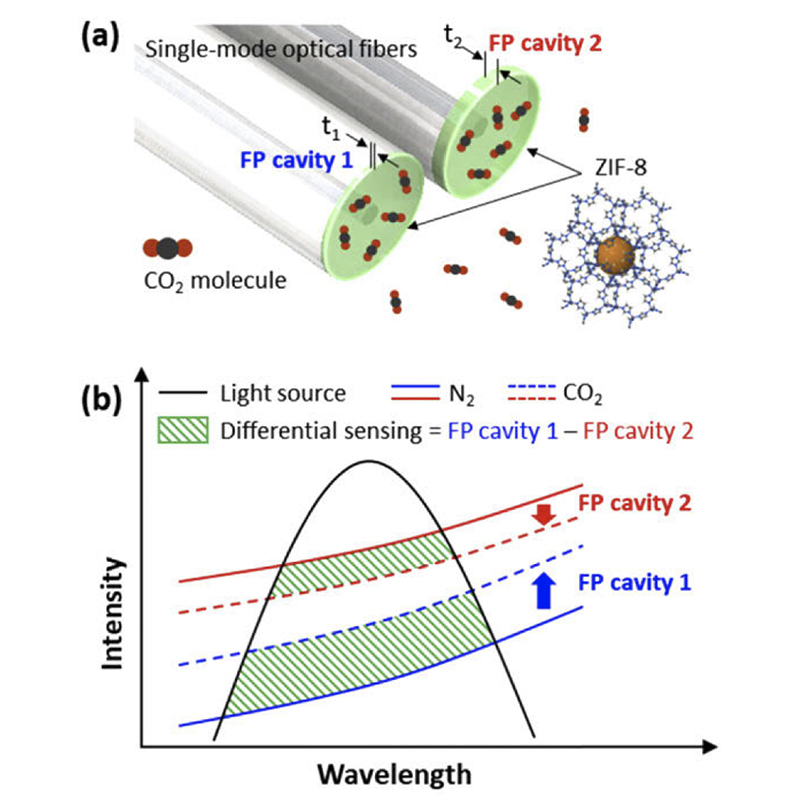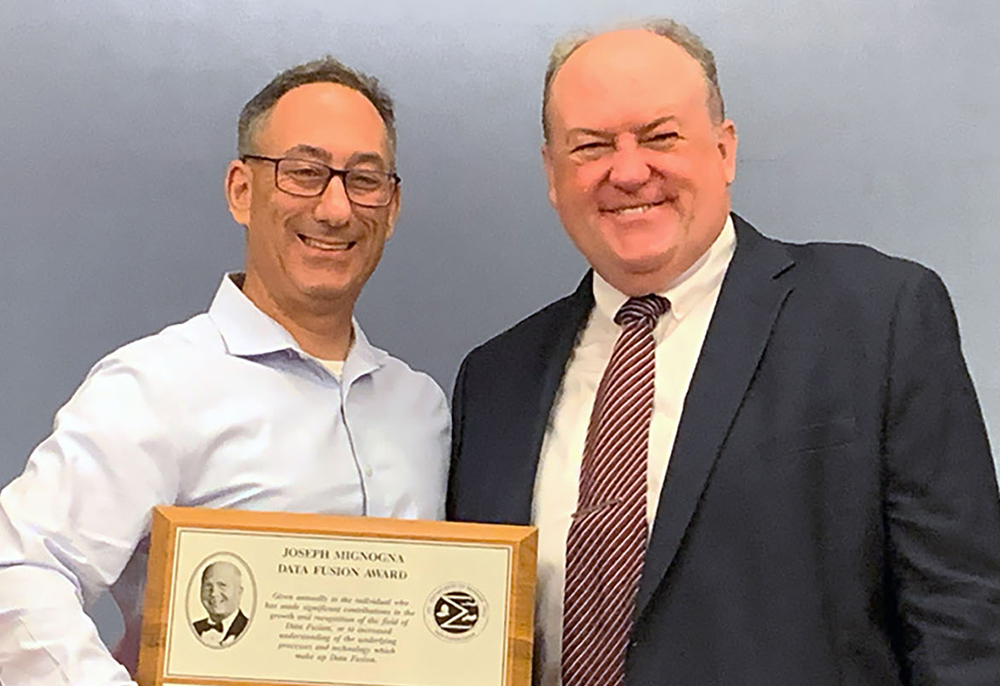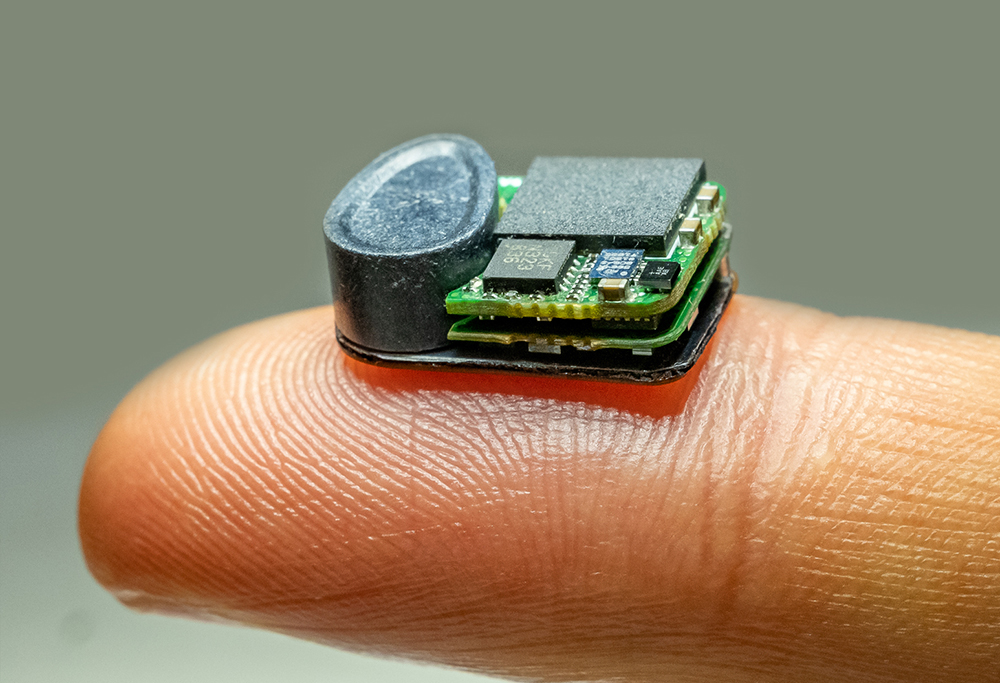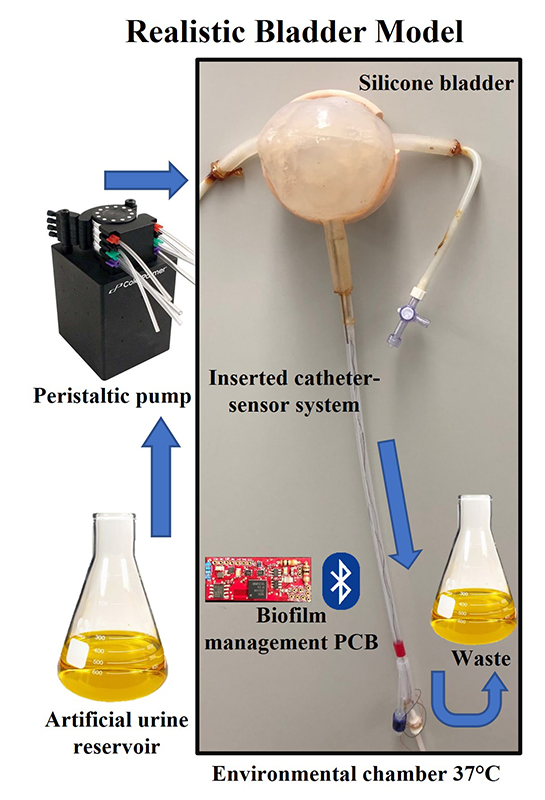News Story
Nanotechnology pushes RI-based gas sensing forward

Fig. 1 from the paper: (a) Schematic of the fiber-optic differential CO2 sensor with ZIF-8-based dual FP nanocavities. (b) Working principle of the differential CO2 sensor. The reflection intensities of the FP cavities 1 (intensity increase) and 2 (intensity decrease) change to opposite directions when the ambient gas changes from N2 (solid red and blue curves) to CO2 (dashed red and blue curves) over the entire wavelength range of interest. By measuring the differential intensity from the two FP cavities with a balanced photoreceiver, the sensitivity can be enhanced. The solid black curve represents the spectral profile of a broadband light source.
Sensors that can detect and measure gases are used in controlling vehicle emissions and indoor air quality, as well as in agriculture, aquaculture, food processing, and medical care. Fiber optic gas sensors are an attractive solution for on-site, real-time gas sensing because of their ruggedness in high temperature and corrosive environments, their remote sensing and multiplexing capabilities, and their immunity to electromagnetic interference.
Fiber optic sensing systems based on refractive-index (RI) are in wide use and can be designed to work in a variety of optical spectral ranges, including near-infrared wavelengths that are commonly used for optical communications. These devices can be used to develop cost-effective and compact RI-based sensing systems. However, because the RI change induced by the variation of gas concentration is extremely small, current RI-based gas sensing is not very sensitive. In addition, RI-based gas sensing is not particularly selective because it cannot provide sensing of a specific gas molecule or compound from a gas mixture.
Because of this, infrared absorption spectroscopy, based on the measurement of molecular fingerprint from gas molecular vibrational and rotational bands, has been widely used for selective and sensitive gas sensing. Unfortunately, most infrared absorption-based gas sensors operate in the mid-infrared range and require bulky and expensive spectrometers.
Recently, nanotechnology advances in metal-organic frameworks (MOF) have shown promise to improve the deficiencies of RI-based gas sensing. MOFs are nanoporous crystalline structures made of metal ions and organic linkers. By engineering pore size, MOFs can be tailored to selectively adsorb specific gas molecules. Additionally, the MOF’s large, porous surface area helps increase gas concentration within it, amplifying the RI change induced by gas concentration variations.
A new paper by Postdoctoral Researcher Hyun-Tae Kim (ME Ph.D. 2017); fellow alumnus Wonseok Hwang (MSE Ph.D. 2017); Yun Liu of the Dalian University of Technology, China; and Professor Miao Yu (ME/ISR) demonstrates a prototype of a new RI-based sensing modality for selective and sensitive sensing of small-molecule gases. Ultracompact gas sensor with metal-organic-framework-based differential fiber-optic Fabry-Perot nanocavities was published in the September 2020 issue of the Optical Society of America’s Optics Express journal.
In their work, the researchers developed an RI-based ultracompact fiber-optic differential gas sensor. They enhanced the sensor’s sensitivity and selectivity to particular gas molecules by using MOF-based dual Fabry-Perot (FP) nanocavities. Their differential sensing scheme leverages the opposite change in the cavity-length-dependent reflection of the two FP cavities, further enhancing the sensitivity.
The researchers fabricated a fiber-optic CO2 sensor with ZIF-8-based dual FP nanocavities for proof of concept. The effective footprint of this sensor was as small as 157μm2, and the sensor showed an enhanced sensitivity of 48.5 mV/CO2Vol%, a dynamic range of 0-100 CO2Vol%, and a resolution of 0.019 CO2Vol% with 1 Hz low-pass filtering. While this sensor was demonstrated for CO2 sensing, when different kinds of MOFs are used, the concept can sense a variety of gases. The sensor also is able to use a wide variety of spectral range, including optical communication bands.
The research was funded by the Office of Naval Research High-Temperature Energy Systems (HiTES) program; the U.S. Department of Agriculture; and the National Institute of Food and Agriculture Sustainable Agricultural Systems (SAS) program.
Published January 27, 2021









